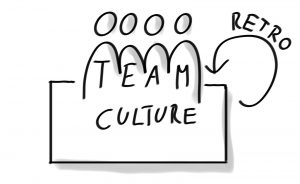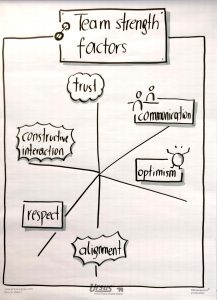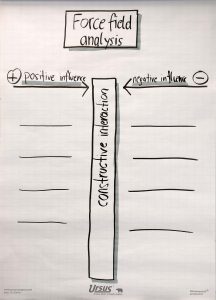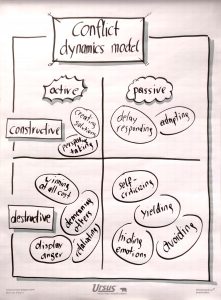A retrospective about team culture

I am coaching agile teams for a while now and have introduced various methods like Kanban, Scrum and SAFe trying to help teams and businesses in their scenarios to deliver better products.
But what makes a good team? The method is just a small part. As you might know, by now, it has a lot to do with psychological safety (see https://hbr.org/2017/08/high-performing-teams-need-psychological-safety-heres-how-to-create-it) and how we interact with each other as a team. As my colleague, the agile drill sergeant puts it: we will now go into the touchy feely stuff, which is a highly rewarding exercise as a coach where you can really put a ding in the teams universe 🙂
In this article I want to present a retro format which I have set together to systematically talk about the teams culture, conflict handling and psychological safety. You should have two hours at least.
Step 1: “Value Stories”
In that specific team, we have agreed upon on a set of values that we want to live in our team (respect, proactivity, etc.). To anchor those values, you can start the retro by asking team members to talk about situations where they have experienced one specific value. You can for example modify that exercise and let the team guess what value the team member is talking about. Using that, you can transform the values from a list of abstract items on the wall to a living instrument. This method is described here: https://management30.com/practice/value-stories/
I also used the big values list from Management 3.0 in the first place to decide upon the values as a team.
Step 2: Team strength factors
I wanted to get a picture about the team health using a spider diagram consisting of five factors: trust, communication, constructive interaction, respect, optimism and alignment. This is taken from the “coaching agile teams” class delivered by the wonderful Lyssa Adkins. If you ever have the chance to take this class, do it, it is eye opening.

team strength factors spider web
I used the productivity strength factor: alignment (common mission or purpose) and four positivity strength factors: trust, respect, constructive interaction and optimism. This is because we had several conflicts lately and I wanted to get into that.
Now, let each team member dot-vote on each axis how good they perceive the situation with this specific factor is.
Then, discuss it and take your time 🙂 Don’t go into this exercise with an expected outcome. Stay neutral.
I got an interesting result on the “constructive interaction” axis which I wanted to analyse further, so I created a force field analysis chart.
Step 3: Force field analysis

force field analysis of “constructive interaction”
I reserved 10 minutes to let everyone think about positive influential factors for “constructive interaction” and negative influential factors.
Then, let people decide if they want to share their insights and put some of them on the chart. It is not necessarily about the documentation, but about the thinking process. Everyone can change his or her behaviour or at least reflect on some situations and participate in a good and constructive interaction.
Take your time to discuss it and find out together, if there are implications for the team.
Step 3: Conflict model
A positive influential factor was “address difficult social and or technical problems”. That and the fact that the team had some conflicts recently, I decided to talk about a team conflict model.
Did you ever make it transparent how a team deals with conflict? No, you’re not alone. But this exercise can help to lay the path for a “conflict protocl agreement” which we didn’t do this time, but I wanted to address the issue and trigger a thinking process. Again, this is taken from the coaching agile teams class.
Basiscally we talked about active constructive, active destructive, passive constructive and active constructive behaviour. If you want to know more, again, I would recommend taking the coaching agile teams class.

conflict dynamics model, source: http://agilecoachinginstitute.com
What you can do now is either try to let people simulate each behaviour or talk about situations where those types of behaviour have been experienced.
In my case, we talked about it and how we can deal with that situations. What I saw, was that it triggered a thinking process which is the best you can expect. For me personally, especially in the passive destructive mode (coming late to standups, don’t participate, stand in the second row, silent) people often don’t realise that this has an effect on the team and people feel that.
If you want to nail it down, you can now start to agree upon a “conflict protocol”, which could contain things like “address conflicts within 24h” and so on. I did not do that, because I was already happy with the outcome.
Closing thoughts
I perceive those kind of retrospectives very challenging, because you never know if people are in the mood for it, but most of the times, going into the emotional part of teams is the most rewarding exercise for me. I also got lots of positive feedback for that retrospective even if we did not agree upon a set of concrete actions.